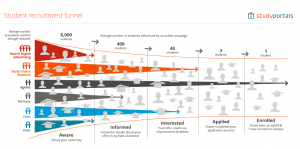How can a small-sized university stand out in the crowded academic marketplace?
University rankings have long been a sensitive topic in higher education and an influential factor in student recruitment. Universities on top of the list are deemed to provide students with the highest quality education and the brightest future, thus leaving millions of students daydream about being on their campuses.
If your institution can’t boast with a high rank, a well-known name, an attractive location and an extensive marketing budget, don’t worry. They are not everything. Focus on promoting the aspects that these can’t measure but which make the student experience on campus worthwhile. Are your prospective students bound to spend the next few years in a truly great and rewarding environment? Each marketing activity of yours should convey this idea loudly and proudly.
Here are the 6 best practices to craft your marketing strategy around. Disclaimer: they take time, effort and a lot of thought, but they actually work.
1. Emphasise your strength
No university scores high on all factors. But the few things it does perfectly is where its competitive advantage lies. Think about the thing your university does like no other. It could offer thorough career coaching, or an innovative teaching approach, or have strong affiliations with companies that grant your students job opportunities. Your institution’s strength should be reflected in its core values and the why of its existence.
For example, being a relatively small university located in the distant city of Vlissingen in the Netherlands, HZ University of Applied Sciences accentuates its core strength in order to stay competitive among other, better-known Dutch institutions in bigger cities. The smaller classes and workshops allow for a more manageable and intimate learning ambience that stimulates group discussions and feedback on the spot. It turns its size, a perceived drawback, into its ultimate advantage for students. The ability to provide them with a more personal and caring approach makes it the place “where students matter”, a slogan it abides by.
2. Differentiate your offer
As academic programmes are becoming more standardised, your chance to differentiate your offer lies with the extras in the package. Make sure to showcase all the unique student clubs and associations, honours programmes, sports facilities, organised activities and causes your university supports. And expand them further if you think they haven’t reached their full potential yet.
They are so important because they have the potential to build student communities around certain interests. And this, in turn, creates a sense of belonging and purposefulness for students. Besides that, these projects help your university build a comprehensive picture of life on campus, which shows your strive to enrich students’ personal lives, develop their abilities and nurture their interests.
3. Show students you care
Your future students represent a generation that adopts new values and beliefs in their interaction with brands. Among those are authenticity and emotional connection, which imply each and every contact your institution has with them needs to be memorable and meaningful.
Your university website will probably be one of students’ first encounters with your brand. Make sure your website shows how much you care about their experience on it. With an intuitive and easy-to-navigate design, display all of the information that will make them aware of the next application steps or will help them visualise themselves on campus.
Emphasise your availability and willingness to connect whenever they feel ready. For example, a “get in touch with a student counsellor” pop-up on your website suggests that if they need to, they will reach a person who can grant understanding, advice and solutions to their questions and doubts. The advantage of a small-sized university is personal communication: the admissions team will have more hands to attend to prospective students personally, increasing the chances of converting them into enrolments.
As for your off-site care, once prospective students turn into leads in your CRM system, send out thank you emails, application deadline reminders, birthday congratulations and why not even “exclusive” insights about the study they have shown interest in. This hints you care about their discovery-process on and off your website and want to guide them through the whole procedure seamlessly.
4. Become a trusted advisor
A truly student-centric institution understands its students’ needs and speaks their language. Content marketing opens up a great opportunity to prove yours does and aims to help them get through the bumps on the road. Start with the information on your website all the way to helpful blog posts. What’s more, blogging is the best way to increase your website SEO value and will contribute to a higher ranking in search results.
Create content around topics that are searchable and relevant for your future students, such as finding accommodation, fees and finances, scholarships, side-job opportunities, and any set of questions that naturally accompanies your student personas’ journey. The data on our portals indicates that the biggest obstacle for students is the financial requirements. This is why it’s important to make this part crystal clear through your content.
And when you have the basics covered? Delight your audience with quirky content that provides for their secondary (but absolutely valid) student-life problems. “5 easy recipes to save your life when you can’t cook”, “Your guide to a more affordable *insert city*”, you get the idea. This type of lighter but relevant content adds up to your institution’s originality and authenticity.
Once you have mastered blogging, take your content strategy to the next level by offering students to request materials such as programme manuals or study guides. This will reinforce your expertise and build a deeper level of trust. To optimize your ROI, connect those downloadable incentives to your CRM system and make sure to follow up with additional valuable content.
5. Invest in the right channels
Using a wide array of channels, including agents, fairs, portals and print media can definitely boost your marketing strategy and reach. However, “the more, the merrier” may not be the most financially feasible way to go about it, nor the most productive.
Before you start investing in marketing tools, evaluate which channels have been the most effective for your institution so far. The student recruitment funnel infographic below gives you an overview of how different channels reach prospective students at different stages of their journey. While some channels increase awareness among visitors but have a minimal click-through rate, others might help you directly enrol students with a very small reach.
If your institution is pressured by a tight marketing budget, you may need to narrow down your investment options to a few. For a detailed review of the effectiveness of the marketing channels out there and the best ways to invest, check out our article “Smart ways to invest your student marketing budget”
6. Develop brand loyalty
Brand loyalty is one of those idealistic terms that are easy to throw around but difficult to cultivate. It takes time, and it takes the mutual effort of your entire staff and current students to accomplish. But it’s the single most valuable intangible asset of your institution and it’s definitely worth the effort.
Every single interaction a (prospective) student has with the faculty, the way issues are resolved and feedback is implemented, even the ambience at the school’s canteen can frame the way your audience perceives you. This is why it’s important to put genuine effort into nurturing the school spirit and the sense of belonging of your students. Highlight your students’ achievements and experiences, be attentive to their needs, and show them how proud you are to have them on board. Your support and appreciation will be echoed in the way they perceive and talk about your brand, making them more likely to recommend your university to friends and leave positive reviews.
Involve your current students and alumni in your marketing strategy by encouraging them to get creative with your content and social media, to help out at open days and to connect with prospective students. For example, the website of Tilburg University offers the possibility to connect with a current student. By filtering the available students by study programme, nationality or language, prospective students receive first-hand relevant information in a more familiar, peer-to-peer manner.
The profitable side of brand loyalty is also known as Customer Lifetime Value (CLV). It is a satisfaction rate indicator that guarantees you a recurring revenue and helps you optimise your marketing strategy not just for recruitment, but for retention too.
Small colleges and universities can easily turn their size into a recruitment advantage. As a small and regionally-ranked university, you know the audience your institution is targeting is rather specific. Instead of dwelling on rankings and large campaigns, invest time in understanding your alumni and prospects and revisit your strategy to employ a unique approach to match their information searches. Focus on building a strong and supportive community of alumni who take pride in their alma mater and would gladly become an ambassador of your institution.
For more updates, follow us!







